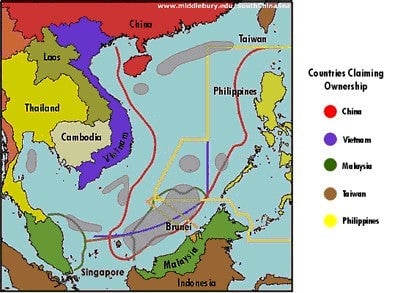Shipwrecks are China’s latest approach to claiming disputed territory
China has many ways of tackling its goal of stretching its territorial claims in the waters off its coasts. One is by air: declaring a new aerial zone. Another is by sea: using its control over shipwreck excavation, as this fascinating Wall Street Journal piece explores (paywall).


China has many ways of tackling its goal of stretching its territorial claims in the waters off its coasts. One is by air: declaring a new aerial zone. Another is by sea: using its control over shipwreck excavation, as this fascinating Wall Street Journal piece explores (paywall).
Take, for instance, the 2012 French-Filipino exploration of a 13th-century Chinese shipwreck in waters that the Philippines and China both now claim, which Chinese naval authorities drove the team from the area, saying the waters belonged to China.
This is the first time one country had invoked force to block another country’s archaeological excavation in the region, as the WSJ reports. The incident came after China announced a crackdown on illegal salvage of historical shipwrecks in its territorial waters. While international law is unclear about how countries should deal with projects in disputed waters, the United Nations recommends joint excavations. However, China has allowed almost no foreign involvement, reports the WSJ.
There’s more than potentially lucrative archaeological findings or the right to control disputed waters behind this crackdown. The submerged remains of Chinese vessels offer evidence for territorial claims.
That’s a major reason why China has ramped up investment in underwater archaeology, investing billions of yuan (link in Chinese) in salvage operations and museums. Government support of underwater cultural heritage projects are explicitly geared toward coordinating “national territorial sovereignty” (link in Chinese).
As the WSJ articles notes, part of the focus on the shipwrecks of the fleets of Zheng He, a Ming dynasty eunuch admiral and China’s most renowned maritime explorer, is due to his having visited islands in disputed waters. Already, government-sponsored projects involving the Paracel Islands, which China seized from Vietnam in 1974, explain that the shipwrecks offer archaeological proof that the Song Dynasty (960-1279 AD) claimed the islands. China also invokes archaeological evidence to boost its claims to the Spratly Islands (pdf p.2), an archipelago rich in oil and natural gas that Brunei, Malaysia, the Philippines, Taiwan and Vietnam all claim as well.

In fact, Chinese officials make these territorial concerns explicit.
“The Philippines sent some French archaeologists to do what? To drag away this shipwreck,” Liu Shuguang, head of China’s Center of Underwater Cultural Heritage, told the WSJ. “Because this was material evidence that Chinese people first found the Scarborough Shoal [the name of the disputed area], they wanted to destroy evidence that was beneficial to China.”
China’s zeal for shipwreck excavation also helps galvanize public support for China’s muscle-flexing in disputed waters. Take, for instance, the Parcels shipwreck exhibition at the Beijing’s Capital Museum: ”China’s sovereignty over the islands of the South China Seas have been formed over a long period of historical development,” says the exhibition summary (link in Chinese). “This exhibition will open the door to public recognition and understanding of China’s southern waters, and make us reflect anew on the historical and cultural underpinnings of this piece of maritime territory.”